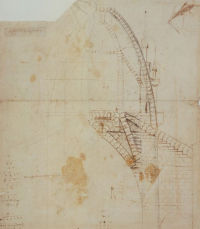Remaking Nature Click on the thumbnails to explore the trail
Read more about this trail (expand)
Leonardo’s ultimate aim was to imitate nature by remaking nature, as opposed to slavishly copying natural forms. This would require a profound understanding of the relationship between the effects of natural appearances and the underlying causes that gave rise to their form. Equipped with this knowledge, Leonardo believed he could create forms equitable to those found in nature, many of which might be of great service to man.

- Enlarge
- Zoom & explore
- Fol 850r -Study on the thrust of arches © Biblioteca Ambrosiana - Auth. No Int 40/05
Codex Atlanticus 1478-1518
By 1480, after more than one hundred years the choir, transepts and nave of Milan Cathedral had been vaulted. But the most difficult task was yet to be completed.
The raising of a tower 50 metres high on narrow piers of only 267 centimetres wide at the crossing of the transept was a formidable structural problem. The placement of a structure of such extreme height on such slender supports presented an enormous challenge.
Between 1487 and 1490, Leonardo pondered the problem. Codex Atlanticus Fol 850r shows one side of the crossing of the transept, between two piers. The section cuts through the large arch joining the piers, the wall built over this arch and the wall erected over the arch of the side aisle. To give rigidity to the overall structure, Leonardo specified stones that would fit into one another in the mode of interlocking vertebrae. In this drawing the individual blocks are represented with anatomical precision. The drawing brings out wonderfully the interplay of forces. In the mode of a skeleton, the structural members alone are weight-bearing rather than the mass of the wall.
In Leonardo's words
It is necessary for the doctors who are the guardians of the sick to understand what man is, what life is and what health is, and in what way a balance and harmony of these elements maintains it….The very same is required by an ailing cathedral – that is a doctor-architect who well understands what a building is, and from what rules are drawn and into what number of parts they are divided…
The Codex Atlanticus is the largest collection of Leonardo’s papers ever assembled, which was originally put together by the sculptor Pompeo Leoni. It takes its name from its large size, being comparable to an atlas.
The Codex Atlanticus reflects every aspect of Leonardo’s interests, including mechanical science, mathematics, astronomy, geography, botany chemistry and anatomy. The drawings represent a broad time-span and are varied in type. Studies relating to painting, sculptural, architectural and engineering projects are also included, such as the Adoration of the Magi altarpiece, the Sforza equestrian monument, and the dome of Milan Cathedral.
The manuscript is now arranged in 12 volumes, comprising of over 1100 miscellaneous drawings and fragments by Leonardo.
- Medium Pen and ink on paper
- Size 61 x 44 cm
- Location Biblioteca Ambrosiana











